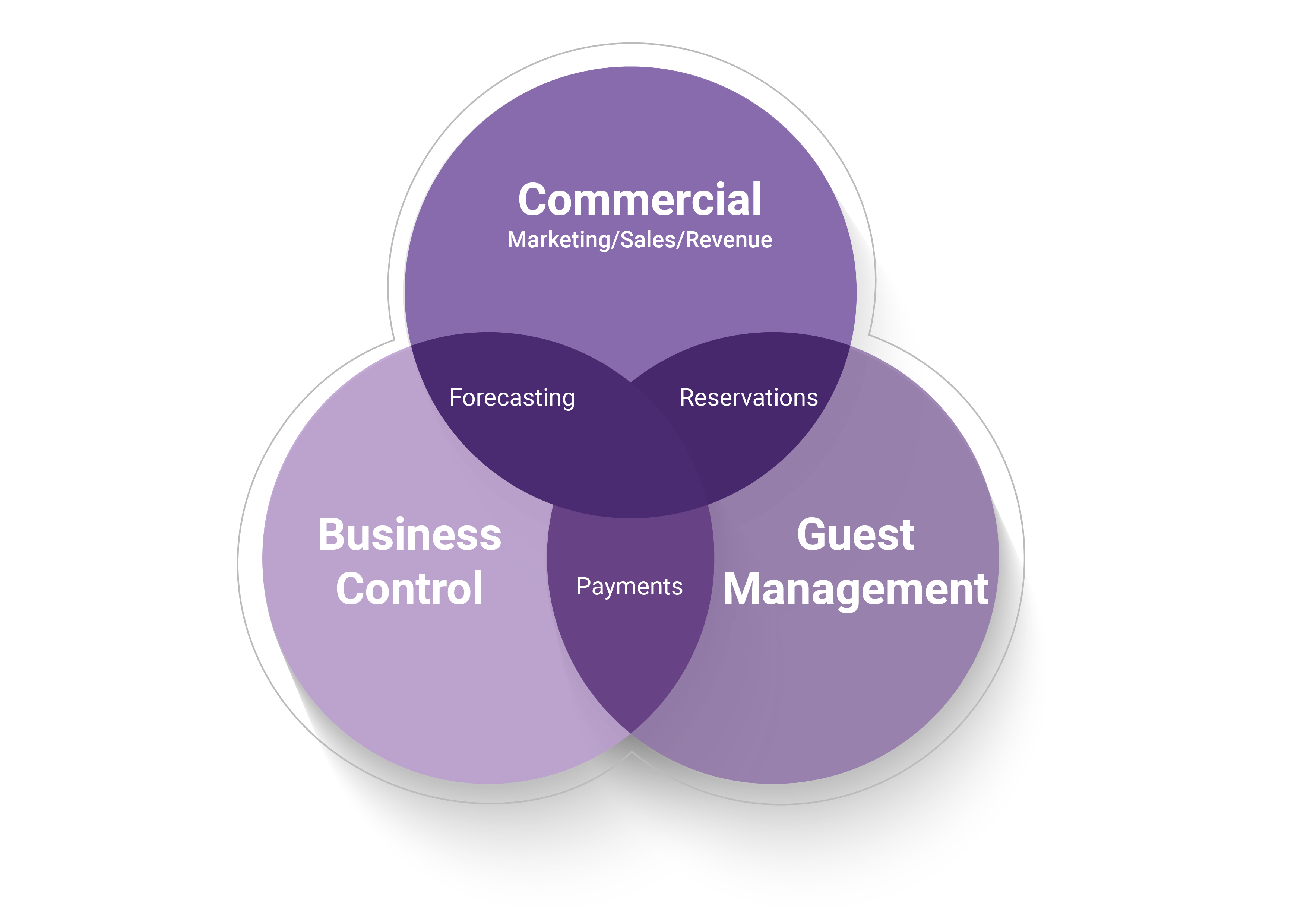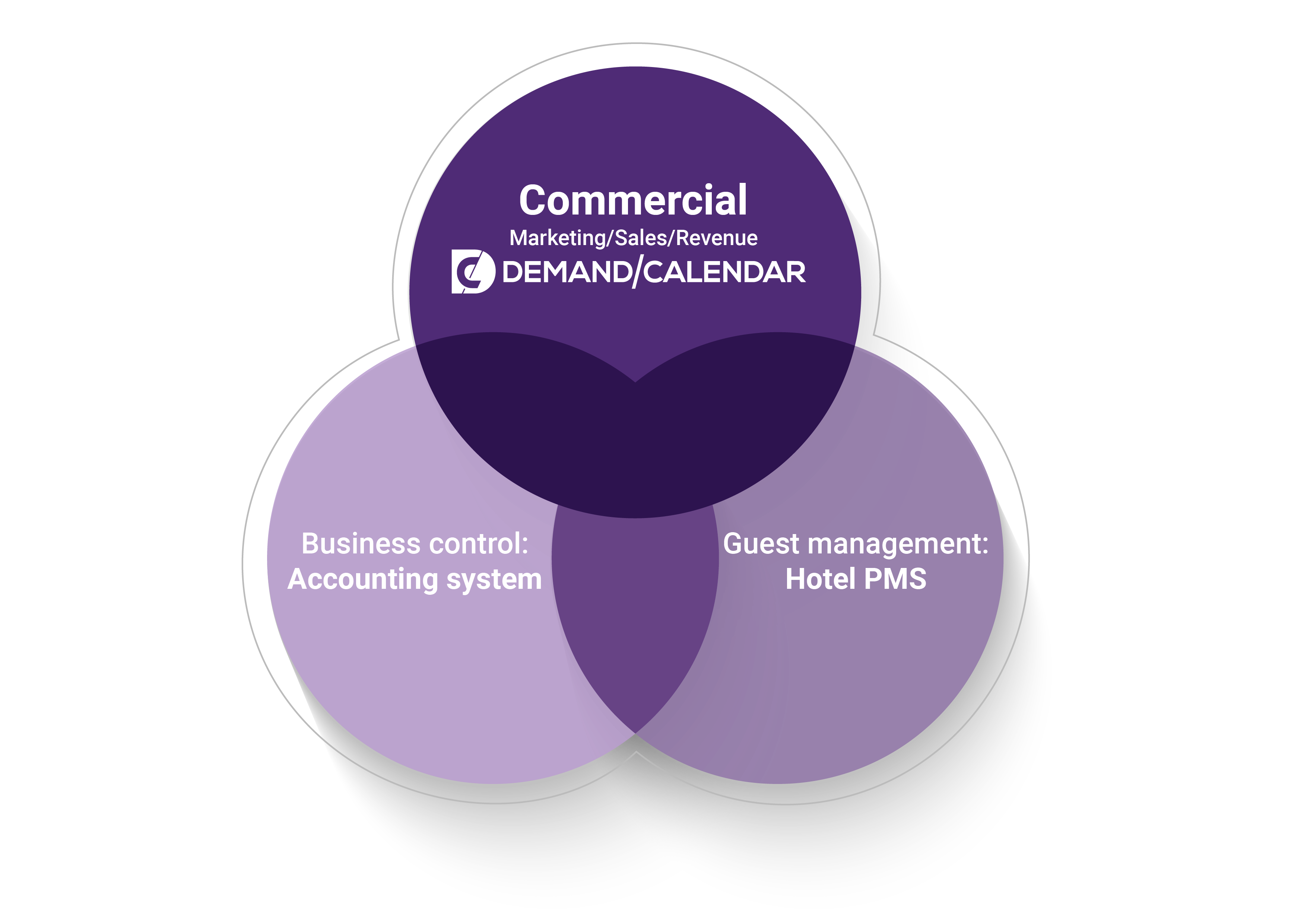The number of systems in use in hotels has grown over time to become an overwhelmingly complex mess. It is time to find a better structure and start to reduce complexity. Here are some ideas on how to categorize systems into the core functions of a hotel business.
Why so many systems in hotels?
Why do you need so many systems to manage a hotel business? The short answer is that each system handles only one specific problem. The apparent reason for this is that each issue is complicated to solve and needs a particular solution. Another problem in the industry is that it seems like no one is happy with their systems. Could there be another reason that the industry has such a fragmented system environment and low satisfaction with all these systems? Let’s dig a little deeper and see if there are some potential solutions to these problems.
The evolution of the hotel PMS
It all started with the hotel PMS. One system that would cover a hotel’s most basic needs in managing reservations, guests, and payments. New requirements evolved over the years. The PMS vendors developed new functionality but could not satisfy all the unique needs of some hotels. The number of systems a hotel needed to manage the business started to grow.
Today the system landscape is overwhelmingly complex since most hotel companies have implemented the best of breed systems for every function. The intentions have been sincere, but it has also created the need for experts to run these systems, lack an overall structure, and difficulties accessing data that sits in silos. With an increased number of systems, the costs have increased and are hard to control.
When the outbreak of COVID-19 started, hotels had to lay-off or furlough many of their experts. Today the hotels do not have the needed expertise to run all the systems, so many systems sit idle waiting for the rebound. Now is the time to re-think what kind of system structure a hotel needs.
A new model for systems in hotels
The pandemic has accelerated many already existing trends, such as digitalization and a new way of working. Hotel guests are already digitalized and have a massive amount of apps in their smartphones to satisfy needs. To be able to continue to stay at hotels during the pandemic guests asked for a higher hygiene standard where touchless could be part of a solution. Changes in guest behavior has made some systems obsolete. New needs will emerge and with them new system solutions.
There is a need for hotels to simplify the complexity and concentrate on the core systems needed to operate a hotel. The starting point is to define which areas are the most important for a hotel to become successful. From a business perspective, a hotel only needs to succeed in three areas to become successful.
- Acquiring customers (guests) - capture the right market share
- Delivery of guest experiences - make guests happy.
- Financial planning and control - secure profitability
In many hotels the CFO (Chief Financial Officer) is responsible for financial, a CCO (Chief Commercial Officer) is responsible for acquiring customers, and a COO (Chief Operating Officer) is responsible for operations and delivering the guest experiences. The titles are different in different hotel companies, but this is a good starting point to reduce complexity.
Circles are the best way to illustrate the relationship between these three major areas
.

This simple model with three circles shows that none of them are silos that can work independently from each other. They overlap and have a need for communication in exchanging information.
The model with the three circles could also be handy and save a lot of time and frustration for hotels and vendors. Hotels would look for solutions within each circle. Vendors would define themselves as being in one of the rings. They would be more focused on solving a need correctly instead of responding with a basic solution based on poorly defined and understood requirements from an existing or potential customer. Let’s explore each circle in more detail.
Business control
The core system in this circle is the accounting system. Hotels are located in many different countries where the company has to comply with local accounting, tax and other legal requirements. Other systems in this circle are budgeting, financial planning and reporting, invoicing, payments, purchasing, staff planning, P&L forecasting, maintenance, real estate management, financial business intelligence, etc. Many of these functions are built into the accounting system, but hotels might need specialized systems for some functions. This circle include all systems that help the hotel to manage its business.
Guest management
The core system here is the property management system (PMS). In this circle there are also Point of Sale system (POS) for the restaurant, a sales and catering system for meetings and events, a spa booking system for managing the spa, and other systems to manage the guest experience. There are also many special guest-facing systems, such as door locks, wifi, TV, telephone, minibar, mobile check-in/check-out, concierge systems, etc. that normally interact with the PMS. This circle include all systems that supports a hotel to create happy guests.
Commercial
This is the circle where almost everything has changed over the past twenty years. Marketing, sales, and revenue management have always worked on acquiring revenue for the hotel. The job is still the same, but the method has changed dramatically over time. There are systems for each role. Marketing uses a loyalty program or guest CRM, sales need a B2B sales CRM, and revenue needs distribution systems and revenue management systems (RMS). The commercial team also uses several supporting systems, such as benchmarking, rate shopping, rate loading, RFP systems, channel management, market business intelligence, Travel Agent analysis, distribution channels, campaign planning, mailing systems, pricing, etc. Each system within the commercial circle is only solving a very specific problem. There is no core system for the commercial team, such as the hotel PMS for managing the guests or the accounting system for tracking the business performance.
One core commercial system
Today Covid-19 not only has reduced the number of people in commercial functions but also reduced the total knowledge to operate the vast number of systems. Demand Calendar is a broad system with core functionality for each role in the commercial team. Everyone in the team will have an overview of future plans as well as incoming business. Each role can also drill down and analyze in detail. The information is collected from many different data sources and is easily accessible in one core system. Some hotels need specialized systems for revenue management or pricing. Data from these systems can automatically be sent to Demand Calendar so the team has a complete view of the business.
 The hotel has to be in the driver’s seat when it comes to understanding their own needs and evaluating systems and vendors.The model with three circles helps define what area the need relates to and where a new system would fit. For many hotels around the world the three core systems, the hotel PMS, a local accounting system and Demand Calendar are all that they need.
The hotel has to be in the driver’s seat when it comes to understanding their own needs and evaluating systems and vendors.The model with three circles helps define what area the need relates to and where a new system would fit. For many hotels around the world the three core systems, the hotel PMS, a local accounting system and Demand Calendar are all that they need.


 The hotel has to be in the driver’s seat when it comes to understanding their own needs and evaluating systems and vendors.The model with three circles helps define what area the need relates to and where a new system would fit. For many hotels around the world the three core systems, the hotel PMS, a local accounting system and Demand Calendar are all that they need.
The hotel has to be in the driver’s seat when it comes to understanding their own needs and evaluating systems and vendors.The model with three circles helps define what area the need relates to and where a new system would fit. For many hotels around the world the three core systems, the hotel PMS, a local accounting system and Demand Calendar are all that they need.